Your Viking clan finds themselves in uncharted surroundings. The land offers some of the resources you’ll need to survive and grow…but the grass appears to be greener, and resources more plentiful, across the border. Do you have the might to drive a rival clan out of those territories and claim them for your own?
Northgard: Uncharted Lands is a 4X game where you’ll eXplore new territory; eXpand your clan’s holdings by moving into those new areas; eXploit the resources in those areas to feed your clan and build helpful structures; and eXterminate your rival clans through combat that (hopefully) drives them from the lands you wish to conquer.
At the same time, Northgard: Uncharted Lands (which I’ll shorten to Northgard for the remainder of this review) is also a deckbuilding game where your hand of cards will determine the actions available to you for a given round. If you don’t manage your deck well, it can easily cost you the game.
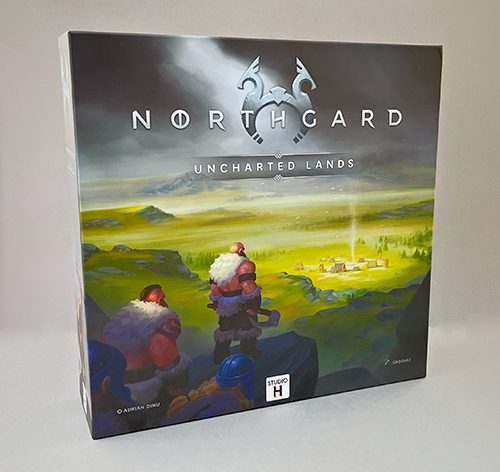
Played over seven Years (rounds), your Viking clan must either end a Year in possession of three closed off territories, each with a large building or, at the end of the seventh Year, have the most fame of any clan. This means Northgard is a tight game that may end sooner than you’d like it to.
Let’s dive into Northgard for a better idea of how this all plays out.
Even In the Sheath, the Sword Must Be Sharp
Players start by choosing a color and taking all the Vikings of that color. As well, they’ll also start off with one food and two wood, and the starting deck of cards that match the color of their Vikings. Each starting deck contains the same six cards:
- Explore: Draw a land tile and place it next to an open territory where you have at least one Viking.
- Move: Move as many of your Vikings across a dashed white border into another territory as you wish.
- Recruit: Add another Viking to any of your clans currently on the board.
- Build: Trade one wood to build a small building or three wood to build a large building in an open building space. (More on these later)
- Feast: These are two wild cards that allow you to take any of the four actions just described.
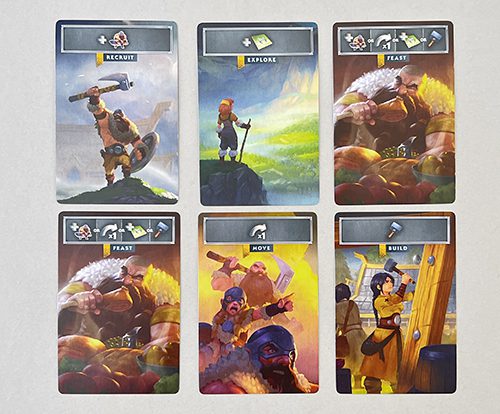
Each player then chooses a faction to play and receives the three cards for that faction. The base faction card gets added to the deck, providing the basis for asymmetric powers within the game. (Each faction also gets a special power, either pertaining to resources or combat.) The two advanced faction cards are set aside and may be added to your deck later in the game.

Set the opening tile in the center of the table (or the two opening tiles in a five player game) and deal each player three land tiles. Players will choose two tiles to play. The first must be placed adjacent to the starting tile, while the second can be placed adjacent to any existing tile. After placing their tile, players also add three of their Vikings to any land segment on that tile.
Tiles are divided into land segments either by dashed white lines or yellow lines. White lines represent standard terrain and only require one Move action to cross, while yellow lines are rough borders and require two Move actions to cross. (At the start of the game, players only have cards that allow for one Move action.)
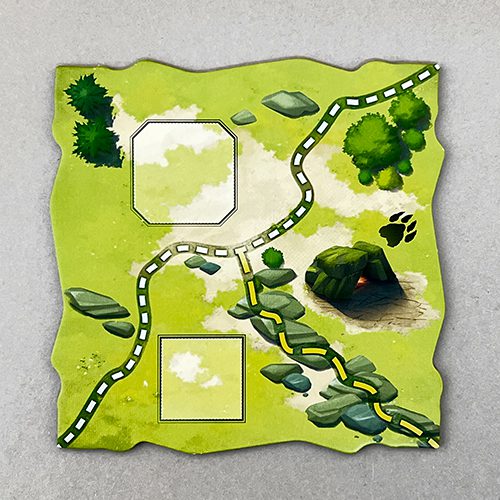
Players will shuffle their seven cards and deal themselves four cards. These will be opening actions available to them in the first Year.
It Often Happens That Things Go By Turns
On a turn, players must play a card from their hand. They can either choose to take the action listed on the card or pass.
You’ll have three sets of cards throughout the game: your draw deck; your current hand of cards that are played into an Action pile; a discard pile made up of your Action pile at the end of a Year. New Years always start with dealing out four cards from the draw deck. The discard deck is only shuffled into the draw deck if the draw deck has three or fewer cards.
Each of the four standard actions is essential to your clan’s ability to thrive. This is because having additional territory to move into will give you greater access to the resources you’ll need at the end of each Year.
Some tiles have resources pre-printed on them. Many have spaces for buildings—smaller squares for small buildings and larger squares with angled corners for large buildings. These buildings are important because they’ll grant you additional access to resources and features you’ll need in the game. Small buildings will get you additional food or wood at the end of the Year, additional Vikings when you Recruit, or inflict casualties if that territory is invaded. Large buildings can either increase your defense, grant you additional Fame, or an extra card in your hand each turn.

To assist with hand management, there is a third resource: Lore. While some tiles do have the Lore icon pre-printed on them, the most common way to achieve Lore is by building a small building dedicated to Lore. This, however, can only be done on specific small building spaces depicting a standing stone.
After playing a card and not taking its Action, you can trade in a single Lore to add the top card of your draw deck to your hand. For two Lore, you can remove a standard card from your hand—and the game—and draw two cards from the top of your draw deck into your hand. For three Lore, you can add one of your clan’s Advanced cards to the top of your draw deck.
Bravery is Half the Victory
The combat system is wonderfully streamlined. After one clan invades the territory of another clan by moving into it, you:
- Add up the number of Vikings for each clan present in the territory.
- Turn in as many food tokens from your supply to your clan as you wish, up to one per clan member, to increase their fighting potential by one. (i.e. five Vikings + four food = a fighting strength of nine.)
- Each combatant, starting with the aggressor, rolls a combat die and factors in the roll.
A combat die can either increase your strength or inflict casualties on your opponent at the end of combat.

The victorious clan remains in the territory, while the defeated clan must move across the border either to a friendly or neutral territory. If neither are available, they are removed from the board.
Great Deeds and Ill Deeds Often Fall Within Each Other’s Shadow
After a player has played their last card, they pass. Once done, they may choose one of the available End-of-Year bonus cards. They place this atop their draw deck.
Once all players have passed, there is a Harvest phase where each player receives the various resources present in the territories they control. As well, players receive Fame based on the size of those territories.
Then Winter comes and you must feed your clan. There is a sliding scale when it comes to food: the more of your clan you have on the board, the more food you must provide for them. When you have more than 10 of your clan on the board, you need to provide them with wood as well as food.
Failure to do so results in having to add an Unrest card to the top of your draw deck. This card will clog up your deck, providing you with an unusable action. This card cannot be removed from your deck by any means and will cost you Fame at the end of Year Seven.
Fear Not Death For the Hour of Your Doom is Set and None May Escape It.
After Winter, comes the end of the Year. If anyone has at least three closed off territories with large buildings built on them, that player immediately wins the game.
If this has not happened by the end of the Seventh Year, all players count up their collected Fame, including any Fame points listed on their cards. The player with the most Fame wins the game.
Where Wolf’s Ears Are, Wolf’s Teeth Are Near
If battling the other clans isn’t enough for you, Northgard comes with a Creatures module to make the game that much more combative and difficult. Creatures spawn on tile territories featuring an animal paw.

Once the tile has been placed, a creature card is drawn and that Creature is placed in the territory with the claw. Each creature card will list the name of the Creature as well as its effects. Three of the four Creatures only cause problems for players, such as prohibiting players from Recruiting in the shared territory or stopping the territory from producing Fame or Resources during the Harvest phase. One Creature, the Fallen Valkyrie, will attack a player when she spawns or moves into a territory.
Yeah, because the Creatures will move. Just before the Harvest phase, all Creatures move towards the Vikings, based on the criteria listed on their Creature cards. The Wolf, for instance, will keep your pre-printed resources from activating during a Harvest, which might just earn you an Outrage card, while the Draugar will immediately move one of your Vikings from the board.
Given their negative effects, you may choose to battle a Creature. When this happens, Combat plays out as usual, with the player to the left of the fighting player rolls the die for the Creature.
Many Travels, Many Fortunes
I think of Northgard as combining the tile-laying aspects of Carcassonne, the slow deckbuilding of Lost Ruins of Arnak, and a simplified Risk-style dice-rolling battle format. From my perspective, these elements all work together to create a game that’s better than the sum of its parts—not that those first two parts are too shabby on their own. (Don’t get me started on Risk’s combat system.) Northgard is an example of what a designer can do when they merge good, familiar mechanics to create a new gaming experience.
The one thing that Northgard does not get right, however, is mitigating the element of luck. I’m not a fan of luck-based games, and Northgard has a fair amount. Your Actions for a given Year are determined by the cards you draw into your hand and if the right cards do not appear, it can be frustrating. With only Seven Years in a standard game, you don’t have the luxury of a restrained turn. If, for instance, your opponent is Recruiting in a territory next to one of yours and you can’t play a card to recruit in response, there’s a good chance you will lose that territory and the resources it produces for you.
My other issue with Northgard is the way the base game frequently just becomes a race to build three large buildings in enclosed territories. We found this strategy caused us each to build settlements away from the other players, either separated by multiple territories or by yellow dashed lines that require two Move actions to cross over.
This second issue changed, however, when we added the Creatures to the game. Just under half the tiles have the distinctive claw marks that indicate a Creature spawning point, so there’s a good chance you’re going to draw these when Exploring. The number of Creatures is limited to the player count + 3 but, as I stated earlier, these Creatures will move before the Harvest phase and will always move towards occupied lands.
This forces players to build more closely together to at least partially deflect the effects of the wandering Creatures. We played one game where a player had his territory well off to the side of the board. When he drew the Fallen Valkyrie, she stayed in his territory, moving back and forth in his areas, mercilessly wiping out his clan Year after Year. Two other players who had adjoining territories, had a Wolf moving back and forth between territories, with the players taking strategic actions to force the Wolf back into the other’s lands.
Stand By Your Own Trial and Not By What Others Say
Despite my concerns, Northgard gets a lot of things right. The game is easy to teach, quick to pick up for new players, and still plays in about 90 minutes. Every game we’ve played has felt different as we’ve explored the various factions and the differences they bring.
However, if you’re looking for the deeply immersive 4X experience of Twilight Imperium this is definitely not the game for you. If you’re looking for something closer to Civilization: A New Dawn or Mosaic, you’re getting warmer. Where you may choose to play Scythe with limited player interaction, in Northgard, the temptation of the resources in those nearby occupied territories makes combat-free sessions an unlikely event.
As a game that intentionally plays out in a much shorter time frame than most 4X games, I think Northgard does an admirable job in creating a fun gaming experience. There’s a difference between simplification and streamlining, where the former simply cuts gameplay elements for complexity while the latter seeks to condense the experience to fit a designated time frame. Will Northgard ever match up with the weekends I’ve spent worldbuilding and battling in the video game version of Civilization V? No. But that’s part of the point for me. I rarely find the time for a 20-30 hour game of Civilization V online. Northgard has earned a place in my collection due to how it distills so many constituent parts of the 4X gaming experience into a playable experience with time to spare.
After my weekly group played our first game of Northgard (in under two hours, including the teach), they all asked to play it again the following week. That next week’s game not only played out more quickly, but was much more intense because we’d all had a glimpse of the possibilities of what the game could deliver. The following week we added the Creatures, and all quickly agreed that we didn’t want to play Northgard without them in the future.
I’ll leave you with this: if it wasn’t for the backlog of board games I need to play test for my reviews here on Meeple Mountain, my gaming group and I would be happy to play Northgard for several weeks in a row. And while duty calls, we’ve all agreed that Northgard will go into regular rotation in our gaming sessions.






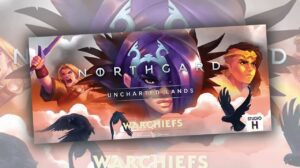
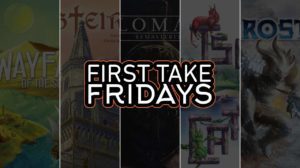




Add Comment